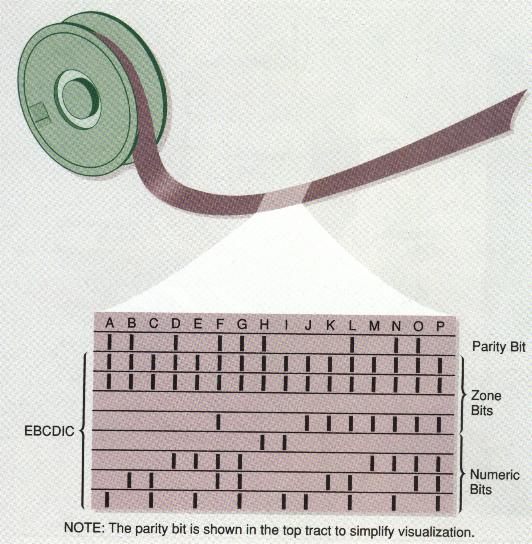
A magnetic tape is a continuous plastic strip wound onto a reel, quite similar to the tape used in reel-to-reel audio recorders. The magnetic tape's plastic base is treated with an iron oxide coating that can be magnetized. Typically, the tape is one-half inch in width. It is wound in lengths from 400 to 3,200 feet. Some magnetic tapes are also packaged in plastic cartridges and cassettes for use with personal computers. Data is stored on magnetic tape by magnetizing small spots of the iron oxide coating on the tape. Although these spots can be read (detected) by the computer, they are invisible to the human eye. Large volumes of information can be stored on a single tape; densities of 1,600 characters per inch are common, and some tapes can store up to 6,250 characters per inch. A typical tape reel 2,400 feet long can store much data as 24,000 pages of doubled-spaced text, while costing only $20 to $30.
The most common method of representing data on magnetic tape uses a nine-track coding scheme, although other coding schemes are also used. When the nine-track method is used, the tape is divided into nine horizontal rows called tracks (see picture below).
Data is represented vertically in columns, one character per column. This method of coding is identical to the Extended Binary Coded Decimal Interchange Code (EBCDIC) used to represent data in some computers' memory. In this way, eight bits and eight of the nine tracks are used to represent each character. The ninth bit and ninth track function as a parity bit.
A magnetic tape is mounted on a tape drive when a program needs the data it contains. The tape drive has a read/write head (which is actually an electromagnet) that creates or detects the magnetized bits as the tape moves past it (see picture below).
When the read/write head is reading data, it detects the magnetized spots and converts them into electrical pulses to send to the CPU. When writing data, the head magnetizes the appropriate spots on the tape, while erasing any data stored there previously.
Individual records on magnetic tape are separated by interrecord gaps (IRGs), as shown below.
These gaps do not contain data but they perform a specific function. When a tape is being read, its entire contents are rarely read all at once. Rather, it is stopped when the end of a record is reached. The tape must then be accelerated to the proper speed before the next record can be read accurately. If this were not the case, the result would be similar to what happens when a phonograph record is played at the wrong speed. The IRG gives the tape time to regain the proper speed before the next record is read. The length of the IRG depends on the speed of the tape drive. If the tape drive is very fast, longer gaps are needed. A slower tape drive requires shorter gaps.
If the records stored on a tape are very short and the IRGs are long, it would be possible for the tape to be more than 50 percent blank, causing the tape drive to stop and accelerate constantly. To avoid this situation, records may be grouped, or blocked, together. These blocked records, or blocks, are separated by interblock gaps (IBGs) as shown in below.
Instead of reading a short record and stopping, then reading another short record and stopping, the read/write head reads a block of records at one time and stops, then reads another block and stops, and so forth. Using the interblock gap method of reading data has two advantages over the interrecord gap method:
Last Updated April 19/99